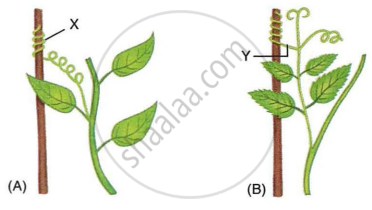Advertisements
Advertisements
प्रश्न
The growth of tendrils in pea plants is due to
विकल्प
effect of light
effect of gravity
rapid cell divisions in tendrillar cells that are away from the support
rapid cell divisions in tendrillar cells in contact with the support
उत्तर
rapid cell divisions in tendrillar cells that are away from the support
Explanation -
Thigmotropism is a type of directional growth movement in response to touch. Cells away from the support showed rapid cell divisions and twine around it.
APPEARS IN
संबंधित प्रश्न
Design an experiment to demonstrate hydrotropism.
How does phototropism occur in a plant stem (or shoot)? Explain with the help of labelled diagrams.
Name five stimuli which act on plants. Name the type of tropism produced by each one of these stimuli.
The growth of tendrils in pea plants is due to the :
(a) effect of sunlight on the tendril cells facing the sun
(b) effect of gravity on the part of tendril hanging down towards the earth
(c) rapid cell division and elongation in tendril cells that are away from the support
(d) rapid cell division and elongation in tendril cells in contact with the support
P, Q, R and S are four major types of phytohormones. P is a phytohormone which functions mainly as a growth inhibitor. It promotes the wilting and falling of leaves. Q, R and S are phytohormones which all promote growth of plants in various ways. Q is responsible for the phenomenon of phototropism in plants. R is involved mainly in shoot extensions. The phytohormone S helps in breaking the dormancy of seeds and buds. What are P, Q, R and S? Give one reason each for your choice.
In tropic movements, plant parts move
Answer the following question.
What is tropism?
What is chlorophyll?
Some plants like pea plants have tendrils which help them to climb up other plants. Explain how is it done. Name the plant hormone responsible for this movement.
Study the diagrams given below and answer the following questions:

- Name the structures shown as X and Y in the figures (A) and (B), respectively.
- Write the functions performed by the structures X and Y.
- Name the phenomenon depicted and define it.
- How do the structures X and Y differ from each other?
- Give examples of the plants which show the said phenomenon.
